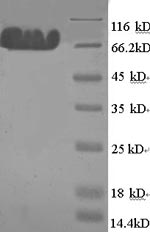Recombinant Rat Microtubule-associated protein tau (Mapt) is produced in E. coli and carries an N-terminal 6xHis-tag that allows for straightforward purification and detection. This protein represents the full length of the mature sequence, covering amino acids 2 to 752. SDS-PAGE analysis confirms purity levels above 90%, which appears to provide reliable performance across different experimental setups. The product is designed strictly for research purposes, though endotoxin levels are not specified.
Tau protein serves as a key structural element in the neuronal cytoskeleton, where it helps stabilize microtubules. Its primary functions seem to center on maintaining neuronal architecture and controlling axonal transport processes. Researchers in neuroscience have shown considerable interest in tau, especially regarding its connection to neurodegenerative diseases. This focus has made it an important target for investigating cellular mechanisms and potentially developing new treatments.
Potential Applications
Note: The applications listed below are based on what we know about this protein's biological functions, published research, and experience from experts in the field. However, we haven't fully tested all of these applications ourselves yet. We'd recommend running some preliminary tests first to make sure they work for your specific research goals.
Based on the provided information, the recombinant rat Microtubule-associated protein tau is expressed in E. coli, a prokaryotic system that is generally unsuitable for producing properly folded full-length tau protein. Tau is an intrinsically disordered protein (IDP) that does not have a stable tertiary structure but requires specific conformational properties for its microtubule-binding function. While E. coli can express soluble tau, the protein is highly prone to aggregation and may not maintain the proper conformational ensemble needed for biological activity. The full-length nature (2-752aa) with an N-terminal 6xHis tag and >90% purity indicates good production quality, but since activity is unverified, the protein cannot be assumed to be properly folded or bioactive without experimental validation of its microtubule-binding capability and prevention of pathological aggregation.
1. Protein-Protein Interaction Studies Using His-Tag Pull-Down Assays
The N-terminal 6xHis tag enables technical feasibility for pull-down assays to identify potential tau-binding partners. However, if the tau protein is misfolded or aggregated (a common issue with full-length tau in E. coli), interactions may not be physiological. The >90% purity reduces background but doesn't guarantee functional conformation. This application requires prior validation of tau's native state and prevention of non-specific aggregation.
2. Antibody Development and Validation
This application is appropriate. The full-length recombinant tau can serve as an effective immunogen for generating antibodies against various tau epitopes. Since tau is an intrinsically disordered protein, antibody recognition is less dependent on tertiary structure. The high purity supports immunization protocols. However, antibodies should be validated against native tau from brain tissues.
3. In Vitro Microtubule Binding Assays
This application is highly dependent on correct conformational properties. If tau is misfolded or aggregated, microtubule binding assays will yield invalid results. The full-length protein contains all microtubule-binding domains, but proper function requires maintaining tau in a non-aggregated, functional state. This application should only be pursued after validating microtubule-binding activity.
4. Biochemical Characterization and Post-Translational Modification Studies
This application is well-suited. The recombinant tau can be used to study aggregation kinetics, phosphorylation by various kinases, and other biochemical properties. The His-tag facilitates purification after modification experiments. These studies are valuable even if the protein's initial activity is unverified.
Final Recommendation & Action Plan
Given tau's tendency to aggregate and the limitations of E. coli expression for this intrinsically disordered protein, recommend first performing biophysical characterization (size-exclusion chromatography with multi-angle light scattering to assess aggregation state, circular dichroism to confirm intrinsic disorder) and functional validation (microtubule binding assays). Antibody development can proceed immediately. Always include fresh protein preparations and aggregation controls in experiments. For reliable functional studies, consider using fresh protein preparations with aggregation inhibitors and validate key findings with native tau.






